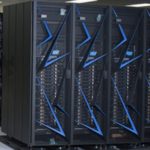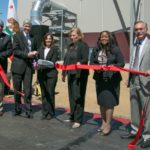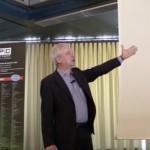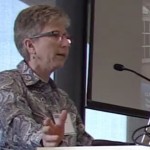Today Energy Secretary Rick Perry announced the DOE has issued a Request for Proposal for 2-3 Exascale machines. “Called CORAL-2, this RFP is for up to $1.8 billion and is completely separate from the $320 million allocated for the Exascale Computing Project in the FY 2018 budget. Those funds are mostly focused at application development and software technology for an exascale software stack.”
IBM Readies Power9 Coral Supercomputers at SC17
In this video from SC17, Ken King describes how new Power9 compute nodes will power the next generation of the world’s most powerful Coral supercomputers at ORNL and LLNL. “We’re pleased to announce that we are delivering on our project, with our next-generation IBM Power Systems with NVIDIA Volta GPUs being deployed at Oak Ridge and Lawrence Livermore National Labs.”
Video: Introducing the 125 Petaflop Sierra Supercomputer
In this video, researchers from Lawrence Livermore National Laboratory describe Sierra, LLNL’s next-generation supercomputer. “The IBM-built advanced technology high-performance system is projected to provide four to six times the sustained performance and be at least seven times more powerful than LLNL’s current most advanced system, Sequoia, with a 125 petaFLOP/s peak. At approximately 11 megawatts, Sierra will also be about five times more power efficient than Sequoia.”
LLNL Dedicates New Supercomputer Facility
Today officials from the Department of Energy’s National Nuclear Security Administration and government representatives today dedicated a new supercomputing facility at Lawrence Livermore National Laboratory (LLNL). The $9.8 million modular and sustainable facility provides the Laboratory flexibility to accommodate future advances in computer technology and meet a rapidly growing demand for unclassified high-performance computing.
Disruptive Opportunities and a Path to Exascale: A Conversation with HPC Visionary Alan Gara of Intel
“We want to encourage and support that collaborative behavior in whatever way we can, because there are a multitude of problems in government agencies and commercial entities that seem to have high performance computing solutions. Think of bringing together the tremendous computational expertise you find from the DOE labs with the problems that someone like the National Institutes of Health is trying to solve. You couple those two together and you really can create something amazing that will affect all our lives. We want to broaden their exposure to the possibilities of HPC and help that along. It’s important, and it will allow all of us in HPC to more broadly impact the world with the large systems as well as the more moderate-scale systems.”
OpenPOWER for HPC Workshop Coming to ISC 2016
Editor’s Note: The OpenPOWER European Summit has been officially postponed until later in 2016, but don’t miss the International Workshop on OpenPOWER for HPC on June 23 at ISC 2016. The OpenPOWER Foundation was established as a non-profit consortium to give its members the ability to innovate software/hardware solutions based on the POWER architecture. About half of […]
Peta-Exa-Zetta: Robert Wisniewski and the Growth of Compute Power
While much noise is being made about the race to exascale, building productive supercomputers really comes down to people and ingenuity. In this special guest feature, Donna Loveland profiles supercomputer architect Robert Wisniewski from Intel. “In combining the threading and memory challenges, there’s an increased need for the hardware to perform synchronization operations, especially intranode ones, efficiently. With more threads utilizing less memory with wider parallelism, it becomes important that they synchronize among themselves efficiently and have access to efficient atomic memory operations. Applications also need to be vectorized to take advantage of the wider FPUs on the chip. While much of the vectorization can be done by compilers, application developers can follow design patterns that aid the compiler’s task.”
Video: OpenPOWER Roadmap Toward CORAL
“Last year IBM together with partners out of the OpenPOWER foundation won two of the multi-year contacts of the US CORAL program. Within these contracts IBM develops an accelerated HPC infrastructure and software development ecosystem that will be a major step towards Exascale Computing. We believe that the CORAL roadmap will enable a massive pull for transformation of HPC codes for accelerated systems. The talk will discuss the IBM HPC strategy, explain the OpenPOWER foundation and the show IBM OpenPOWER roadmap for CORAL and beyond.”
Video: The Road to the Sierra/Coral Supercomputer
“As it readies for Sierra, a new IBM-based platform, LLNL is not only defining the metrics as it paves the road to Coral, it is taking the first giant steps on the path toward Exascale. This talk will provide an overview of Coral and reveal the plans and progress to evolve applications for Sierra and future large-scale systems.”
Radio Free HPC Looks at the Top HPC Tech Stories from 2015
In this podcast, the Radio Free HPC team looks at the Top Technology Stories for High Performance Computing in 2015. “From 3D XPoint memory to Co-Design Architecture and NVM Express, these new approaches are poised to have a significant impact on supercomputing in the near future.” We also take a look at the most-shared stories from 2015.













